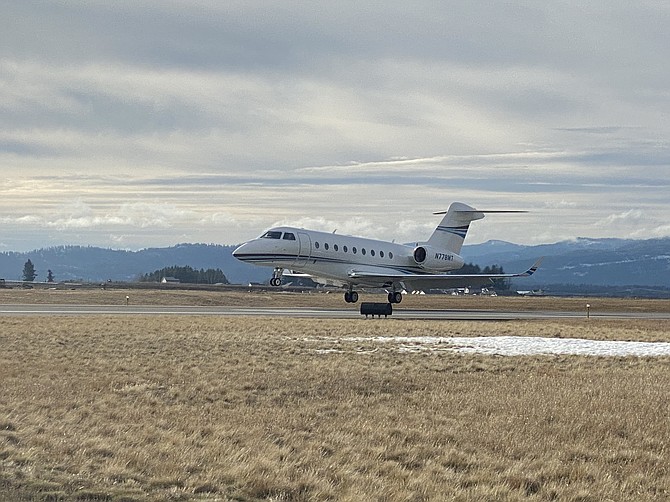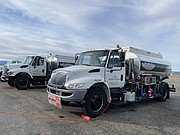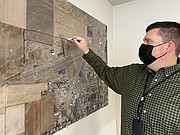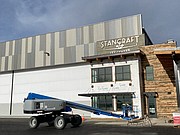Coeur d'Alene Airport: Let's talk business

Heavy traffic has led Coeur d'Alene Airport officials to suggest the time is near for construction of a control tower.
According to the Coeur d'Alene Airport/Pappy Boyington Field manager, there are three options for the facility to grow:
• Continue as a general aviation airport.
• Become a heavy maintenance provider for larger planes.
• Attract commercial airlines.
The first avenue is simple — continuing operations much like it is now.
The other two are more complicated, relying on a hefty amount of dollar signs and interest from the community and industrial entities. Each takes time, about 20 years, manager Steven Kjergaard estimated, but both are possible.
To bring in commercial carriers like Delta or United, the airport would need a terminal — which Kjergaard said could cost at least $40 million. Next comes TSA services, another multi-year process.
"There's always a possibility of commercial service because you never know," he said. "We are getting bigger, and the certificates we hold make commercial a possibility. The issue for that becomes the initial investment cost."
Kjergaard fields a couple calls a year from commercial airlines expressing interest in the airport, he said. Yet without a terminal, it becomes challenging and unlikely.
County liaison to the airport, Kootenai County Commissioner Bill Brooks, has also heard rumors about commercial airlines in Coeur d'Alene, but none have panned out.
"I don't think it's ever going to be a commercial airport, not in my lifetime or for a long time after that," Brooks said. "It's a place where general aviation type pilots can enjoy and fly to and from."
No problem. The airport thrives off of general aviation activity. According to the 2020 Idaho Airport System Plan Update, Coeur d'Alene Airport supplied over 1,000 jobs in the community and reported an economic impact of over $200 million. If the airport continues in GA operations, Kjergaard said the next 20 years would see increased hangar construction and various aircraft usage. It just wouldn't produce a lot of what everybody is after: Jobs.
"Staying in general aviation with some flight schools and things like that is going to have minimal opportunities for job creation," Kjergaard said. "And that is where we look at what the community wants from growth."
To become a heavy maintenance facility, the airport would rely on investments from developers like StanCraft Jet Center and Empire Airlines. This avenue would provide more mechanical and industrial positions than general operations.
"There are very good prospects for the airport's future in aircraft maintenance," Brooks said. "The fixed-base operators there already are the kind of services the airport needs as a business entity."
StanCraft Jet Center, a full-service fixed-base operator, provides concierge, fueling, and line service to associated aircraft. Recently the company began constructing a new $15 million facility on the north side of the airport, with two more hangars planned in the future. The building — featuring several parking areas, a 30,000 square foot hangar, 10,000 square feet of storage space, and a terminal-like room, is the largest investment to the airport in years, Kjergaard said.
"It's a very positive change for the airport," he said. "It will provide a much better entry point to the airport, allows for much larger aircraft to land here overnight and operate during inclement weather."
In the past few years, various businesses have formed around the airport like StanCraft, Empire, aviation schools, shipping companies and construction groups. Revenue from these sources, and general hangar owners, has helped diminish the airport's financial dependency on the county.
Annually, the airport takes about $300,000 to $400,000 in county property taxes to subsidize operations, Kjergaard said. But for the 2021 budget year, the airport required only about $160,000. Next year Kjergaard hopes to take none.
"We've been slowly shrinking our need down over the last few years to become an enterprise fund, where we take no money from property taxes to cover costs," he said.
To continue that practice, the airport will need to attract more interest from general aviation pilots and larger companies to build revenue. However, the southwest side of the property is almost full, Kjergaard said, and the north side is filling up fast.
While this growth will aid the airport, developing the facility is limited because of cost, Brooks said. With the brunt of the Federal Aviation Administration's funding tied up in a decoupling project that is now on pause, other needs are kicked down the road.
"We can't plan much until we have a path forward for decoupling the runways, and if they don't, we have a good chance of losing our funding from the FAA," Brooks said. "The county cannot very well do a big project when right now it benefits a relatively few number of people."
To better suit the taxpayers it serves and create a more profitable airport, Brooks believes a new set of authority figures should lead future planning decisions. Through local, county, and airport officials' combined efforts, the Coeur d'Alene Airport/Pappy Boyington Field's future will be determined.














